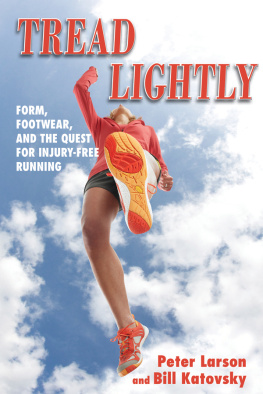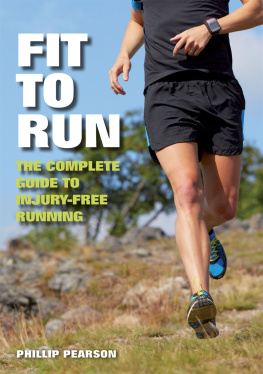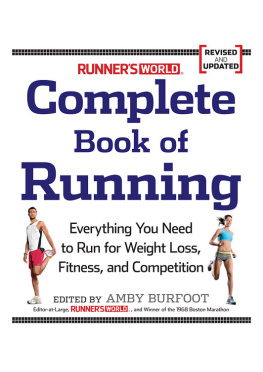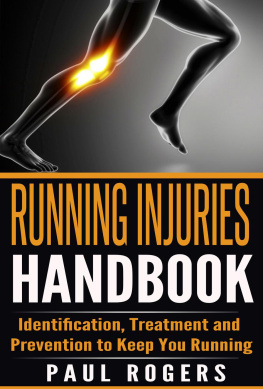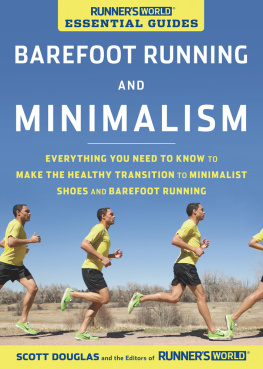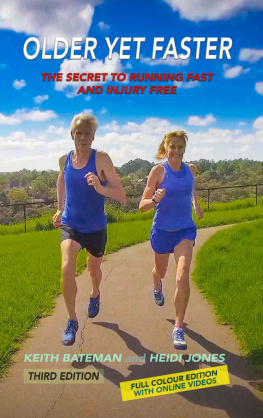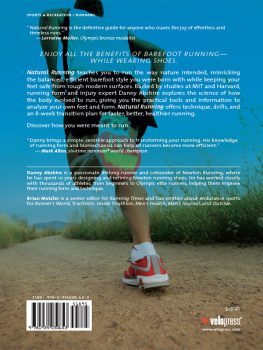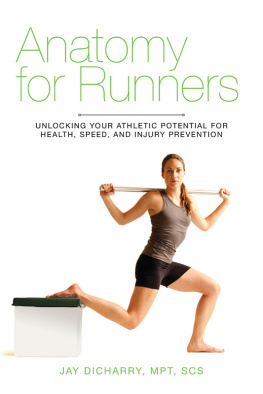
TREAD LIGHTLY
FORM, FOOTWEAR, AND THE QUEST FOR INJURY-FREE RUNNING
Peter Larson and Bill Katovsky

Skyhorse Publishing
Copyright 2012 by Peter Larson and Bill Katovsky
All Rights Reserved. No part of this book may be reproduced in any manner without the express written consent of the publisher, except in the case of brief excerpts in critical reviews or articles. All inquiries should be addressed to Skyhorse Publishing, 307 West 36th Street, 11th Floor, New York, NY 10018.
Skyhorse Publishing books may be purchased in bulk at special discounts for sales promotion, corporate gifts, fund-raising, or educational purposes. Special editions can also be created to specifications. For details, contact the Special Sales Department, Skyhorse Publishing, 307 West 36th Street, 11th Floor, New York, NY 10018 or
Skyhorse and Skyhorse Publishing are registered trademarks of Skyhorse Publishing, Inc., a Delaware corporation.
Visit our website at www.skyhorsepublishing.com.
Cover photo courtesy of Merrell
This book provides extensive information about running injuries, running footwear, running form, and nutrition. In the process of presenting these topics, we discuss numerous scientific articles, books, and other publications. Any errors in quotation or interpretation are the fault of the authors, and not of the sources.
Information presented in this book does not constitute medical advice. Outcomes resulting from choosing new footwear, altering running form, and making changes to your training can be difficult to predict, and injuries are possible. We recommend consulting with a qualified medical practitioner prior to making any change.
10 9 8 7 6 5 4 3 2 1
Library of Congress Cataloging-in-Publication Data is available on file.
ISBN: 978-1-61608-374-8
Printed in the United States of America
To Erin, Anders, Emma, and Benjamin. Your understanding, support, and patience made this book possible.
PML
Each of us is an experiment of oneobserver and subjectmaking choices, living with them, recording the effects.
GEORGE SHEEHAN, M.D.
Contents
Introduction
Petes Story and Bills Story
Preface
When you come to think of it, some few (comparatively) centuries ago there was only one law which appealed to all and sundry. But its appeal was imperative. Four words will cover itEat, or be eaten. In those days mankind had to rely on legs to be in a position to carry out the first part or evade the latter. So everyone ran and ate; when they failed to run fast or far enough they met the eater... at that time instinct kept the race perpetually fit.
ARTHUR NEWTON, RUNNING, 1935
L egendary South African ultrarunner Arthur Newton recognized something very important when he wrote the above passage in his 1935 book titled Running. Decades before Christopher McDougall shook up many conventional beliefs about running with a bestselling book about his experience with the Tarahumara Indians of Mexicos Copper Canyon, Newton realized that humans were natural born runners. Newton was like many of todays runnershe didnt start running seriously until he was 38 years old, and the initial experience of going just two miles left him stiff for several days.
An autodidact when it came to running, Newton loved to experiment with different training methods and approaches to fueling and hydration, including making an energy drink from lemonade and salt. He tended to think a lot about running form, finding that his perfect stride length was three feet, seven inches, and that his ideal footwear were cheap canvas sneakers with crepe-rubber soles that seldom needed replacing. He regularly logged over 500 running miles per month, won the Comrades Marathon several times, and set multiple ultramarathon world records (including at 60 and 100 miles). His 24-hour distance record of 152 miles stood for over two decades.
As the worlds best endurance runner at the time, Newton was somewhat of a fitness proselytizer, like an earlier version of Dr. George Sheehan and Jim Fixx, both of whom also became born-again runners in early middle age. The South African athlete passionately believed that it was entirely possible for anyone who put in the necessary time and effort to become a runner. Yet Newton was a realist who acknowledged that the average man of his day was in a fairly poor physical state: the physique of the ordinary individual is not cut out for, nor reasonably capable of, sudden enormous exertions such as are entailed by a twenty-six mile race, owing to the adverse conditions brought about by modern civilization.
Few people nowadays would disagree with Newtons observation. Homo sapiens is a running species, but modern society for the most part has shunned running or exercise with any level of regularity. And those of us who do decide to take up running are often saddled with chronic or recurring injuries, and are left wondering why.
Could many of our running-injury woes be tied directly to unhealthy aspects of a modern lifestyle? Most of us simply dont live like our ancestors; nor do we tend to use our body in the manner that drove its evolution to its current state. Instead of hunting and gathering and being active for a good portion of the day, we tend to be sedentary and eat heavily processed and sugary foods rather than fresh meats, fruits, and vegetables. Even serious runners often find that much of their day is spent slouched in an office chair in front of a computer, all the while wearing shoes that can impact their anatomy and biomechanics. When the runner finally makes it out the door for a workout, its usually on unyielding, unvarying man-made surfaces instead of sand, dirt, and irregular rocky terrain. The list could go on and on.
Our goal in writing Tread Lightly was not to provide an exhaustive review of how modern life negatively affects ones health and running, but rather to examine three specific changes that are of particular importance and relevance: footwear, form, and food.
We start at the beginning and discuss how man developed his unique running prowess through evolution via natural selection. From there we move on to a discussion why we should run and why we tend to get hurt while doing so. We then focus on footwear history and how shoes and gait play a significant role in both causing and correcting the ills of the modern runner. Nutrition is examined in this context. By weaving together information pulled from experts, coaches, doctors, and scientists, we hope to make the strong and persuasive argument that running should be enjoyable, and not a source of discomfort, pain, or serial misery. Once youre armed with the knowledge obtained from this book, its our hope that you will be able to look at running in a whole new light.
Peter Larson and Bill Katovsky
April 2012
Introduction
Out on the roads there is fitness and self-discovery and the persons we were destined to be.
GEORGE SHEEHAN, M.D.
Petes Story
How does a college professor in the hard sciences develop an obsession with running shoes? Its an interesting question and one that I often ask myself when gearing up for a run and choosing from among the over fifty pairs of colorful shoes that comprise my collection. Professors are supposed to wear sensible shoes and tweed jackets with elbow patches, not tech gear and flashy racing flats with bright orange flames on the sides. I have a problem, and I openly admit itshoes fascinate me, but not for reasons of aesthetics or status. Instead, Im curious about how footwear is designed and how shoes allow ones body to work. I teach human anatomy and exercise physiology, so the study of form and function is what gets my creative and analytical juices flowing at full speed.
Next page
